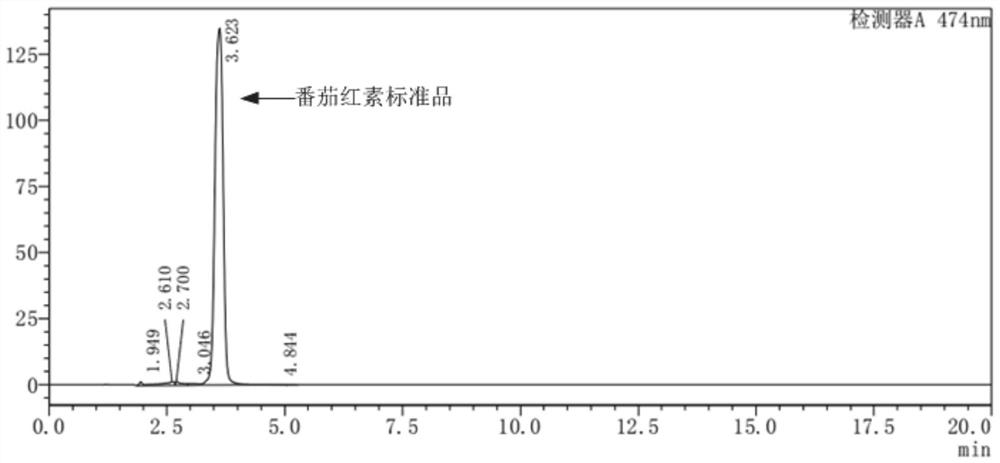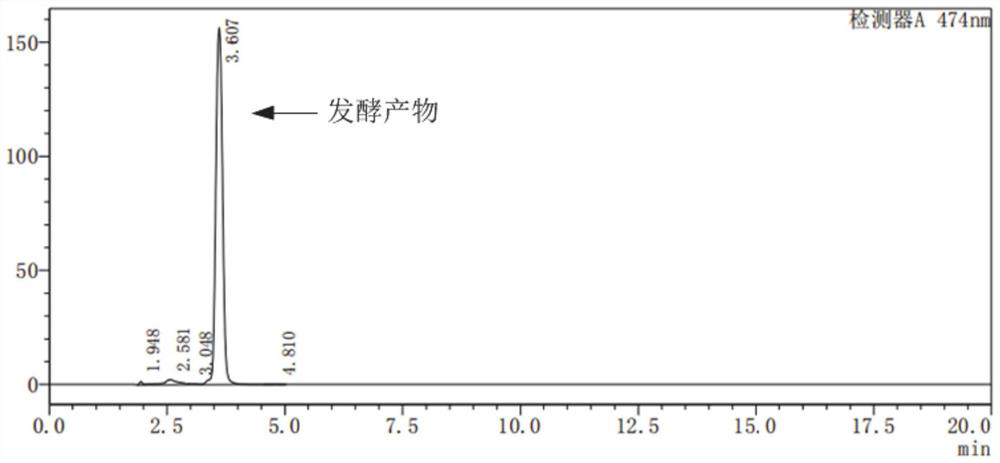Recombinant lactococcus lactis used for generating lycopene, and application of recombinant lactococcus lactis
A technology of Lactococcus lactis and lycopene, applied in the field of recombinant Lactococcus lactis and its construction, can solve the problems such as the inability of Lactococcus lactis to synthesize lycopene, and achieve the effect of broad application prospects
- Summary
- Abstract
- Description
- Claims
- Application Information
AI Technical Summary
Problems solved by technology
Method used
Image
Examples
Embodiment 1
[0019] Example 1: Elimination of competing branches of lycopene synthesis precursors in Lactococcus lactis
[0020] Using CRISPR / Cas9 combined with single-strand DNA recombination engineering, the lactate dehydrogenase pathway and α-acetolactate synthase pathway, which are competing branches of lycopene synthesis precursors in Lactococcus lactis NZ9000, were eliminated. The method for eliminating the above competition branch is to knock out the partial nucleotide sequence of the ldh gene and the partial nucleotide sequence of the als gene on the chromosome of Lactococcus lactis NZ9000.
[0021] The related method of using CRISPR / Cas9 combined with single-stranded DNA recombination engineering to knock out the chromosome segment of Lactococcus lactis has been disclosed in the paper Microb Cell Fact (2019) 18:22.
[0022] (1) Partial nucleotide sequence of knockout ldh gene
[0023] The specific method of knocking out the partial nucleotide sequence of ldh gene:
[0024] ① Con...
Embodiment 2
[0062] Example 2: Synthesis of Lycopene Gene Expression Recombinant Plasmid
[0063]The recombinant Lactococcus lactis producing lycopene of the present invention eliminates two competing pathways of its lycopene synthesis precursors in Lactococcus lactis: lactate dehydrogenase pathway and α-acetolactate synthase pathway ; then construct and obtain after introducing exogenous expression elements into the strain; wherein the elimination of the lactate dehydrogenase pathway and the α-acetolactate synthase pathway is by knocking out part of the core of the ldh and als genes in the Lactococcus lactis NZ9000 genome The nucleotide sequence is realized; the exogenous expression elements are geranylgeranyl pyrophosphate synthase gene crtE, phytoene synthase gene crtB and phytoene dehydrogenase gene derived from Pantoea pineapple crtI, the nucleotide sequence of crtE, crtB and crtI is represented by crtEBI, with a total of 3372 bases, and its nucleotide sequence is shown in SEQ ID No:3...
Embodiment 3
[0064] Embodiment 3: Construction of Lactococcus lactis producing lycopene according to the present invention
[0065] The recombinant plasmid pSEC:crtEBI was electrotransformed into Lactococcus lactis NZ9000ΔldhΔals to obtain the recombinant lycopene producing strain NZ9000ΔldhΔals / pSEC:crtEBI.
[0066] The above-mentioned electrotransformation method is:
[0067] ① Activate Lactococcus lactis NZ9000ΔldhΔals overnight in GM17 medium, transfer to SolI at a ratio of 2%, and culture statically at 30°C until OD600=0.4. Centrifuge at 6000rpm at 4°C for 10 minutes to collect the bacterial cells, wash the bacterial cells twice with SolII, resuspend the bacterial cells in SolII of 1 / 50 of the original culture volume, and obtain competent cells;
[0068] ② Add 50ng of pSEC:crtEBI to the competent cells, blow and aspirate to mix well, and then transfer them to a pre-cooled electroporation cup.
[0069] ③Set the electrotransformation parameters of the electrotransfer instrument as fol...
PUM
 Login to View More
Login to View More Abstract
Description
Claims
Application Information
 Login to View More
Login to View More - R&D
- Intellectual Property
- Life Sciences
- Materials
- Tech Scout
- Unparalleled Data Quality
- Higher Quality Content
- 60% Fewer Hallucinations
Browse by: Latest US Patents, China's latest patents, Technical Efficacy Thesaurus, Application Domain, Technology Topic, Popular Technical Reports.
© 2025 PatSnap. All rights reserved.Legal|Privacy policy|Modern Slavery Act Transparency Statement|Sitemap|About US| Contact US: help@patsnap.com


